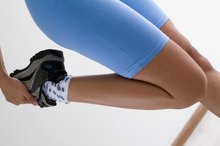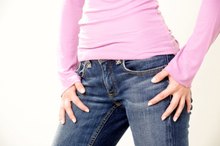Stretches for Thoracic Paraspinal Muscles
If you spend a lot of time sitting at a desk, driving or working at a computer, it's likely that your upper back muscles -- thoracic paraspinal muscles -- are tight.
The paraspinal muscles run along the sides of your spine and their job is to help keep you in an upright position. Perform stretching exercises throughout the day to decrease tightness in these muscles.
Read more: The Best Exercises for Thoracic Back Pain
Chair Stretch
Stretch your right and left thoracic paraspinals with the chair stretch.
Tensor Fasciae Latae Muscle Stretches
Learn More
Sit up straight in your chair. Begin with your hands resting on your thighs.
Lift one arm straight up overhead and reach your hand toward the ceiling until you feel a stretch in your upper back.
How to Stretch the Quadratus Lumborum
Learn More
Hold this position for 20 to 30 seconds, then relax. Repeat three times on each side.
Seated Rotation
The seated rotation exercise stretches the thoracic paraspinals by twisting the upper body. Sit in a chair without arms or lower your armrests if you're able to move them out of the way.
Sit up straight in a chair. Cross your arms so that your forearms are resting on top of each other. Raise your arms up to shoulder-height.
Slowly rotate your upper body to the right and look over your right shoulder. Stop when you feel a strong but comfortable stretch in your upper back.
Hold this position for 20-30 seconds and repeat three times. Perform this stretch on the opposite side.
Standing Side Stretch
Standing stretches are more intense than seated stretches. Move slowly into the standing side stretch to avoid pain.
Stand with your feet approximately shoulder-width apart. Stretch your right side by placing your left hand on your left hip. Reach overhead with your right arm.
Slowly lean your upper body to the left. Don't bend forward or backward -- lean directly to the side.
Stop when you feel a strong stretch along the right side of your upper back. Hold for 20 to 30 seconds. Repeat three times, then switch sides.
Forward Reach
The forward reach stretch can be performed from a sitting or standing position. Be careful not to allow your lower back to round forward -- stand or sit up straight throughout this stretch.
Hold your arms out straight in front of you and interlock your fingers.
Push forward with your hands until you feel a stretch in your upper back. Your shoulders will round forward during this movement.
Hold this position for 20 to 30 seconds, then relax. Repeat three times.
Read more: The Best Foam Exercise Roller
Foam Roller Stretches
Foam rollers use body weight to massage and stretch tight muscles.
Sit on the floor and place the foam roller sideways, behind your back.
Bend your knees and lean back onto the roller. Begin the stretch with the roller under your shoulder blades. Put your hands behind your head to support your neck.
Press down through your heels and lift your buttocks off the ground. Using your legs, slowly roll up and down the roller, keeping it between the top and bottom of your ribcage. Roll for 30 to 60 seconds at a time.
Tennis Ball Massage
Massaging tight muscles increases blood flow to the area and helps the muscles relax. Perform tennis ball massage with other thoracic paraspinal stretches or by itself.
Stand with your back against a wall. Place the tennis ball behind one shoulder and lean back to hold it in place.
Slowly step sideways until the ball is positioned on your thoracic paraspinals on one side of your spine.
Carefully squat down and stand back up to roll the ball along the target muscle. Perform this for 30 to 60 seconds, then repeat on the opposite side. Do not roll the ball across your spine -- this could cause pain.
Related Articles
References
- Amercian Academy of Orthopaedic Surgeons: Spine Conditioning Program
- Journal of Physical Therapy Science: Effect of Thoracic Stretching, Thoracic Extension Exercise and Exercises for Cervical and Scapular Posture on Thoracic Kyphosis Angle and Upper Thoracic Pain
- Lurati AR. Health issues and injury risks associated with prolonged sitting and sedentary lifestyles. Workplace Health Saf. 2018;66(6):285-290. doi:10.1177/2165079917737558
- Nakphet N, Chaikumarn M, Janwantanakul P. Effect of different types of rest-break interventions on neck and shoulder muscle activity, perceived discomfort and productivity in symptomatic VDU operators: A randomized controlled trial. Int J Occup Saf Ergon. 2014;20(2):339-53. doi:10.1080/10803548.2014.11077048
- Cooley D, Pedersen S. A pilot study of increasing nonpurposeful movement breaks at work as a means of reducing prolonged sitting. J Environ Public Health. 2013;2013:128376. doi:10.1155/2013/128376
- Daneshmandi H, Choobineh A, Ghaem H, Karimi M. Adverse effects of prolonged sitting behavior on the general health of office workers. J Lifestyle Med. 2017;7(2):69-75. doi:10.15280/jlm.2017.7.2.69
- Henning RA, Jacques P, Kissel GV, Sullivan AB, Alteras-Webb SM. Frequent short rest breaks from computer work: Effects on productivity and well-being at two field sites. Ergonomics. 1997;40(1):78-91. doi:10.1080/001401397188396
- Ylinen J, Kautiainen H, Wirén K, Häkkinen A. Stretching exercises vs manual therapy in treatment of chronic neck pain: A randomized, controlled cross-over trial. J Rehabil Med. 2007;39(2):126-32. doi:10.2340/16501977-0015
Writer Bio
Aubrey Bailey has been writing health-related articles since 2009. Her articles have appeared in ADVANCE for Physical Therapy & Rehab Medicine. She holds a Bachelor of Science in physical therapy and Bachelor of Arts in psychology from the University at Buffalo, as well as a post-professional Doctor of Physical Therapy from Utica College. Dr. Bailey is also a certified hand therapist.








